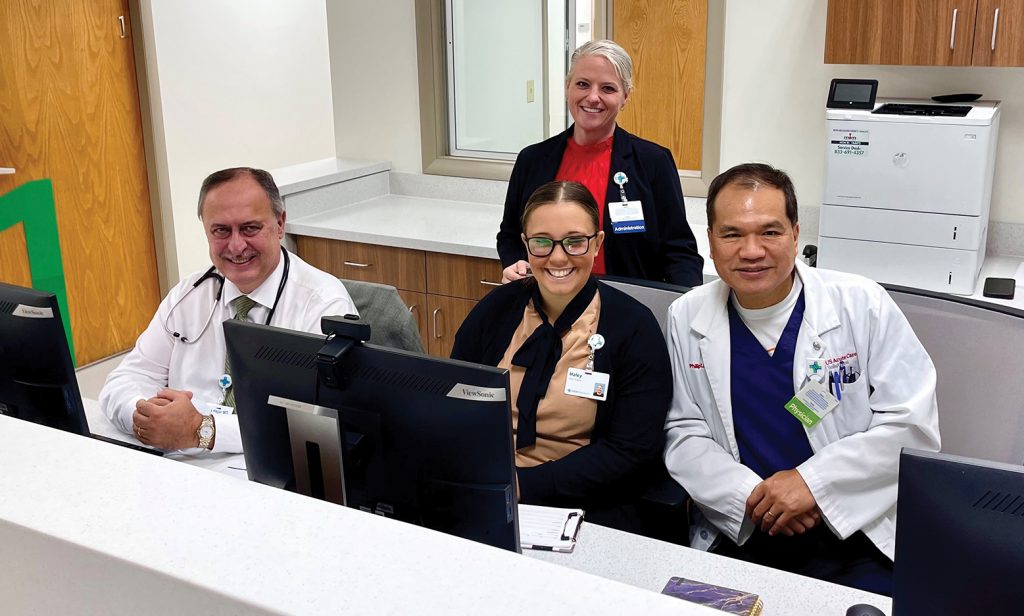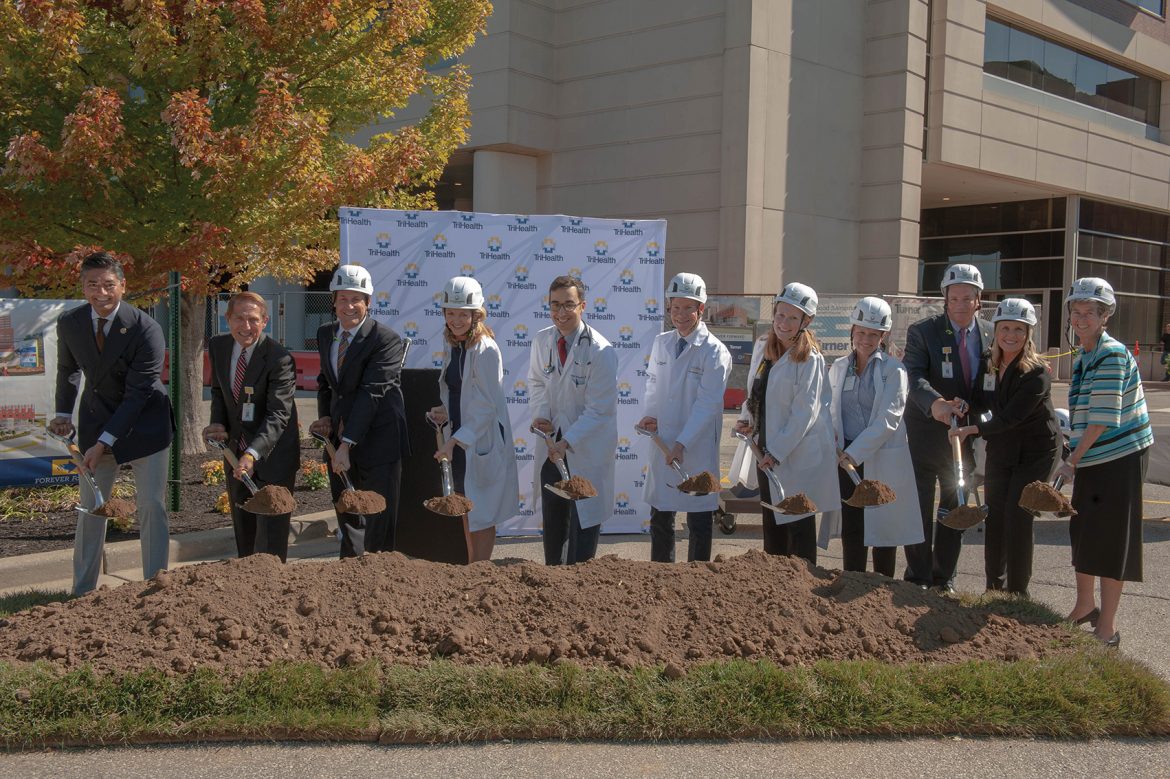Dan takes his first steps gingerly, supported on his right by a uniformed nurse and on his left by the encouraging words and strong shoulder of his physical therapist. Only a few hours earlier, surgeons had replaced his right knee—the one worn to the bone by years of hardcourt tennis and, lately, ill-advised pickleball dives—with a titanium substitute. Now that the local anesthesia has worn off, he’s walking the halls of TriHealth’s new Finneytown outpatient center.
By dinnertime, Dan will be holding court in his favorite chair, stroking his Black Lab’s shiny coat and enjoying some pampering from his wife and kids not the hospital’s second shift. “Better technology, more advanced implants, less invasive surgical techniques,” says TriHealth CEO Mark Clement. “That’s what’s changed as our industry has evolved, and it’s meant that we can get our patients out of the hospital setting faster with better clinical results and at a lower cost.”
Today, Clement says, hospitals more often focus on the very sick or severely injured. And while new hospitals are still being built around the country and here in the Cincinnati region, new infrastructure is more often built for rehabilitation, specialty services, and outpatient care. These brick-and-mortar facilities also house private practices and support additional medical buildings and supplier businesses within a stone’s throw of the front door. The Finneytown facility is TriHealth’s 13th ambulatory health care center.
Check out the sprawling Mercy Hospital business corridor in Anderson Township or The Christ Hospital Health Network’s medical center near Liberty Center mall in Butler County’s Liberty Township. Or how UC Health’s 160-bed West Chester Hospital, now 14 years old, has helped boost the Tylersville Road economy in Warren County.
Two hospitals are now under construction in the rapidly growing area around Mason. Christ is constructing a 157,000-square-foot, 60-bed facility on Innovation Way, while Bon Secours Mercy Health is building Kings Mill Hospital, a similar sized facility near Kings Island. Both hospitals will employ more than 200 with plenty of room to grow—empirical evidence that health care is a key driver of economic development. Mason Economic Director Michele Blair has said for every position these new medical facilities create, 2.5 additional jobs are likely to be created in and around the community.
Perhaps no other system has built more infrastructure in recent years than Cincinnati Children’s. From Batesville and Greensburg in southeastern Indiana to its newest venture along the I-75 corridor in Centerville, the nation’s top ranked children’s hospital has expanded its reach beyond its Avondale campus. That campus itself has seen tremendous expansion, with the opening two years ago of its $600 million critical care building.
In the northern suburbs, Children’s partnered with UC Health in 2016 to build a Proton Therapy Center on their Liberty Center campus, bringing innovative targeted kids’ cancer treatment to our region. The latest project, now underway, is construction of 12 extended-stay apartments on the Liberty campus, which families of cancer patients can use while their child is undergoing treatment.
Also on the books and ready for shovels, hammers, and welders are a 25,000-square-foot medical facility Union, Kentucky, that will focus predominantly on primary care and a 110,000-square-foot health care center in the Eastgate area, near TQL’s headquarters at U.S. 32 and Interstate 275. Both will open next year.
“We’re making the investment so that the children of Clermont County as well as the communities to the east can receive world class health care closer to their homes,” says Children’s Chief Operating Officer Evaline Alessandrini, MD. Children’s is the largest hospital system in the Cincinnati region and the second largest employer overall, with more than 18,400 staff.
A common rationale for hospitals when they make the decision to invest in large infrastructure projects is: You assess the need, and you go where the patients are.
“We feel strongly that people want their health care close to home,” says Brian Gwyn, Mercy’s market president in Cincinnati. “We hear this from our patients all the time. Your doctor is local. Your pharmacy is probably just a few miles away. When it’s an emergency or if you need imaging or physical therapy, you want it close by.”
Clement agrees that people want to be able to access health care within a 15-minute drive from their home. “Patients want and we are delivering a one-stop shopping experience for health care at TriHealth,” he says.
TriHealth’s flagship hospitals are Good Samaritan in Clifton and Bethesda North in Montgomery. It also operates Bethesda Butler in Hamilton, Bethesda Arrow Springs in Lebanon, and McCullough-Hyde in Oxford and is part of a joint venture with Select Medical operating TriHealth Rehabilitation Hospital on Dana Avenue.
But its future isn’t focused on adding to the community’s inventory of complex acute care hospitals, says Clement. “We have not opened a new hospital in the nine years I’ve been here,” he says, “and we don’t have any plans to do so in the future.’’ Instead, he explains, TriHealth will continue to refine a unique business model that awards them more for promoting preventative health care than for the traditional fee-for-service compensation that’s governed the U.S. medical industry for years.
Clement believes the long-term commitment to preventative health care among TriHealth’s 600,000-strong patient community and its work with the federal government to create what he calls a “value-based payment system” will keep people out of the hospital and reward TriHealth for its efficiency and improved community health. “We’ve had to be a disrupter in our industry and take a lot of risk to do this,” he says, “but we’re already seeing results.”

Hospital utilization rates (defined as admissions per 1,000 people) are declining and, says Clement, “we’re looking at a lot of empty beds.” Hospitals like Deaconess have closed or consolidated, and many are hurting financially. COVID accelerated what the American Hospital Association last fall called “the worst financial crisis since the pandemic began.” A report the group commissioned predicted that more than half of U.S. hospitals and perhaps as many as two-thirds would operate in the red in 2023.
“Hospitals did prove they were an essential role in dealing with COVID,” says John Palmer of the Ohio Hospital Association. “But workforce issues—where the magic happens—took a beating. The burnout among clinicians, doctors, nurses, and support staff was high, and we’re still feeling the effects.”
Palmer says a recent report indicated that more than 600 U.S. hospitals are facing an existential financial crisis. In addition to staffing shortages, he says, hospitals contend with chronic supply chain issues, changes in Medicare reimbursement, and general inflation. “A full 10 percent in Ohio are at risk of closing,” he says, “many of them in our rural areas.” Palmer noted that eight of Ohio’s 88 counties currently have no hospital at all.
So where are the patients? Why are so many beds empty? We’re getting older—shouldn’t we be getting sicker, too? “COVID taught us there is absolutely a need for acute care hospitals,” Gwyn says. “People were really sick and couldn’t be treated in an outpatient setting, so we were overwhelmed at Mercy. In a pandemic, you absolutely need those beds and there weren’t enough of them.”
Hospitals, both Clement and Gwyn acknowledge, are for the seriously ill or injured—as the medical professionals define it, when the patient’s case mix index approaches 2.0. For context, a natural birth is about a 0.5, sepsis is 2.5, and an organ transplant or a condition requiring a ventilator could be a 4 or 5.
Clement says TriHealth’s inpatient case mix index is around 2.1, higher than it used to be and longer in duration. “You’re admitted when you have complex medical issues that require close monitoring and meds,” Clement says. “But now, thanks in large part to advances in technology, we can provide robust quality health care less expensively at home.”
Technology allowed Dan to get a new knee and be home in time for dinner. Technology enables a wheelchair-bound patient to video conference with her primary care physician instead of enduring a long ride downtown for a routine examination. A patient with a rare disease could, similarly, confer with a specialist based in Los Angeles. Electronic medical records make sharing patient history a breeze, saving time and perhaps lives.
Health care executives, in making the decision to build infrastructure, may need to negotiate through different hierarchical structures and approval mechanisms, but they appear to use similar factors in determining whether to proceed. Is there a geographical gap in health care services—a so-called “medical desert?” Is there a growing need for nearby specialized care services? Is it possible to partner with or piggyback on the services that already exist in the community? Is there a patient load sufficient to support the investment?
Can we provide the necessary staffing? Is land available? And, importantly, does the community want the new facility? Community support, Gwyn and Clement note, is paramount. “It’s important to coordinate with the community and develop a rap port with the leadership,” says Gwyn. “Typically, they are very supportive. They know it will drive the economy for the whole region as well as providing close-by medical care.”

Still, there can be issues as new buildings with large numbers of employees change the community’s physical and sometimes economic environment. The uncertain economy is playing a role, too, especially as interest rates rise. A December 2022 study from the American Institute of Architects (AIA) reported that nearly 40 percent of its members have experienced an increase in project delays since COVID and 28 percent called the slowdown a serious issue. AIA has urged its members to recognize the economic pressures facing medical group executives and “offer predictable, quick and attractive solutions who are desperate for support, but hesitant to invest in conceptual ideas.”
Planners work hard to design facilities that can integrate swiftly not just today’s technology, but what might come tomorrow. Gwyn quotes Wayne Gretsky’s famous “skate where the puck is going to be” philosophy when describing Mercy’s building designs but admits that the technology moves more quickly than a slap shot. “We design for providing electronic records and digital imaging that a doctor can pull up instantly on his cellphone he says. “But in the future, we’ll be looking at artificial intelligence, 3D organ printing, predictive medicine, and more.”
Hospital construction trends nationwide are tech-centered, says Hamilton Espinosa, one of the country’s leading health care experts at DPR Construction in Phoenix. “The pandemic health care organizations need to adapt their physical infrastructures to support the demands of technology-enabled omnichannel patient experience,” he writes in a May blog.
For new construction, that means health care providers, architects, and construction managers will need to consider how quickly digital technology may advance. What digital infrastructure needs to be installed as the concrete, steel, and dry wall go up that will not only support today’s technology but tomorrow’s? It means a new approach to building design, such as providing dedicated spaces for private telemedicine sessions or improved air filtration systems. It means modularity and scalability, encouraging features like movable walls so rooms can be reconfigured when the technology changes.
And it means more attention to PX, a term that means patient experience. There will be a focus on more private rooms, anti-microbial surfaces to reduce in-patient infections, interior lighting that soothes rather than stuns, and more creature comforts for family members who may spend hours at their loved one’s bedside.

Clement, while not planning to build acute care hospitals in the near term, agrees that TriHealth’s facilities need the same technological footprint. Whether in a hospital bed or simply getting an X-ray at an ambulatory care facility, he believes the improvements in technology are critical to the patient experience and ultimately their health outcomes. At the same time, he’s quick to say, the human touch matters as well. He touts Tri-Health’s care team concept—doctors, nurses, pharmacists, specialists, mental care and physical therapists, nutritionists—as being the key to good health care outcomes and says the data supports it’s already made significant gains in reducing hypertension, a1c levels, and diabetes as well early cancer detection. Still, he says, the effectiveness of that human element relies on the technologies they can employ.
“Business loves this too, because preventative care and wellness programs are much less expensive than traditional what I call ‘sick care,’ ” says Clement. “Every system is perfectly designed to deliver the results it delivers, and that’s why we believe it’s important to evolve our business away from the broken system it’s been.” That means, for TriHealth, no more acute care hospitals (at least for now) and more neighborhood-based, fully-wired-for-action medical and rehabilitation centers.
Mercy, while still building full-service hospitals, shares TriHealth’s focus on prevention and wellness. It will take time, Gwyn says, and resolve. “We need to make sure people are educated, exercising, getting the right nutrition, and taking their medication,” he says. “We need and want to be more proactive, especially with patients who have chronic conditions. If we can make health care more convenient for the patient, we’ll have a better chance to get that message across.”


